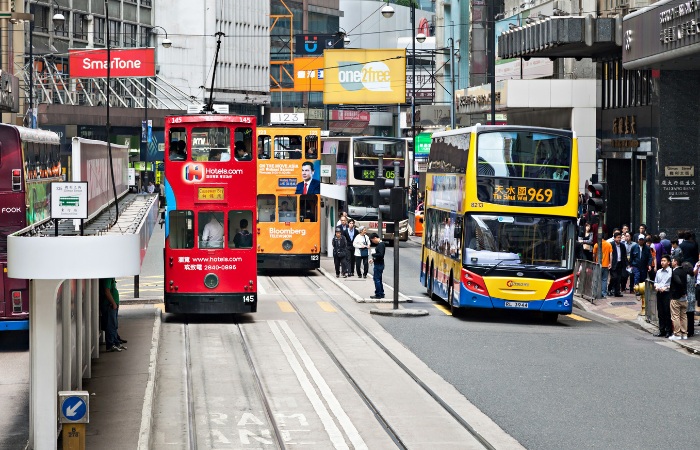How Does Public Transport Reduce Traffic Congestion?

Traffic congestion is a major issue in many urban areas worldwide, causing frustration, wasted time, and increased pollution levels. While many solutions can help alleviate this problem, public transport is often considered one of the most effective. But how exactly does public transport reduce traffic congestion?
Public transport reduces traffic congestion by increasing capacity and providing time savings, safety, cost savings, and environmental impact. It allows more people to travel at once and reduces the number of cars on the road, saving time and money for commuters.
In this blog, we will explore the various ways in which public transport can help reduce traffic congestion. So, let’s dive in and discover how public transport can play a vital role in addressing the issue of traffic congestion.
What Does Traffic Congestion Mean In City?
Traffic congestion in a city refers to a situation where the demand for transportation exceeds the road capacity, resulting in a slowdown or complete halt of traffic flows. This can cause delays, increased travel time, and traffic jams for public transit and private vehicles.
In some cases, it can also lead to increased fuel consumption and air pollution. To reduce traffic congestion, cities may invest in public transport systems, create exclusive transit lanes, or optimize traffic signals. In the United States, cities like San Francisco have implemented public transit projects to reduce traffic congestion.
How Does Public Transport Reduce Traffic Congestion?
Public transport is an efficient means of transportation in urban areas. It is crucial in reducing traffic congestion, a significant problem in many cities worldwide.
Increased Capacity
Public transport systems such as buses, trains, and trams have larger carrying capacities than private vehicles, meaning more people can travel using the same amount of road space. This reduces the number of vehicles on the road and can help to ease traffic congestion during peak travel times.
Time Savings
Public transport systems can reduce travel times by providing exclusive transit lanes, which allow buses and trams to bypass traffic congestion. Additionally, public transit routes are optimized to cover high-demand areas, reducing travel times for passengers.
Safety
By reducing the number of private vehicles on the road, public transport systems can also reduce the risk of accidents and improve overall road safety. Additionally, trained professionals typically drive public transport vehicles, reducing the risk of accidents.
Cost Savings
Using public transport can also save commuters money on fuel, vehicle maintenance, and parking costs. This can incentivize people to use public transit instead of driving, reducing the number of vehicles on the road and easing traffic congestion.
Environmental Impact
Public transport systems can also reduce the environmental impact of transportation by reducing the number of vehicles on the road and thus decreasing fuel consumption and emissions. This can have a significant positive impact on air quality and public health.
Read Also: Why Is Travel Important For Cultural Understanding?
How Can We Reduce Traffic Congestion Using Public Transport?
Traffic congestion is a significant problem in many cities around the world. Congestion causes delays, frustration, and increased pollution levels. One way to reduce traffic congestion is by promoting public transport. Here are some ways to achieve this:
- Improve Public Transportation: To encourage people to use public transport, it needs to be reliable, frequent, and affordable. Investment in public transport systems can improve the quality of services, making them more attractive to users. This can include upgrading existing routes, adding new routes, and increasing the number of vehicles in operation.
- Encourage Carpooling: Carpooling is another way to reduce traffic congestion. This involves sharing a ride with other passengers traveling to the same destination. This reduces the number of vehicles on the road and, in turn, reduces traffic congestion. Employers can encourage carpooling by incentivizing employees who carpool, such as preferred parking spots.
- Reduce Congestion Pricing: Some cities have implemented congestion pricing, which involves charging drivers a fee to enter certain areas during peak hours. It can reduce the number of vehicles on the road during peak hours and reduce traffic congestion. However, it can also be controversial, as it disproportionately affects low-income drivers.
- Increase Enforcement of Traffic Violations: Another way to reduce traffic congestion is by increasing enforcement of traffic violations. This can include cracking down on illegal parking, speeding, and other traffic violations. This can help keep traffic flowing more smoothly and reduce congestion caused by unnecessary delays.
- Improve Road Infrastructure: Improving road infrastructure can also help reduce traffic congestion. This can include increasing road capacity, improving traffic flows, and adding exclusive transit lanes for public transit. In San Francisco, for example, creating exclusive transit lanes has helped enhance public transit services and reduce traffic congestion.
Challenges and Limitations of Public Transport as a Congestion-Reducing Solution
Public transport systems are often proposed as a solution to reduce traffic congestion in cities, but they face several challenges and limitations.
Road Capacity and Traffic Flows
Public transportation systems operate on fixed routes, which may not align with demand, resulting in the underutilization of some routes and overcrowding of others. Additionally, exclusive transit lanes can limit road capacity, causing traffic congestion for private vehicles.
Travel Time and Convenience
Public transit is often slower than private vehicles, and passengers may need to make transfers or wait for buses or trains. This inconvenience can discourage people from using public transportation, even if it reduces traffic congestion.
Funding and Implementation
Public transit projects require significant funding and political will to implement. Many projects face opposition from residents who do not want to sacrifice road space or parking for transit infrastructure.
Location and Accessibility
Public transportation systems may not reach all city areas, especially suburban or rural areas. This limited coverage can discourage people from using public transit and increase demand for private vehicles.
Alternative Solutions To Public Transport For Reducing Traffic Congestion
Traffic congestion is a significant problem in many cities across the world. Public transport systems are often seen as a solution but are not always effective. Here are some alternative solutions to public transport for reducing traffic congestion:
- Carpooling: Carpooling involves sharing a ride with others with a similar route. This can significantly reduce the number of vehicles on the road, reducing traffic congestion. Companies can encourage carpooling by offering incentives such as reserved parking spaces for carpoolers.
- Bicycling: Bicycling is an eco-friendly alternative to driving. It not only reduces traffic congestion but also helps reduce air pollution. Cities can encourage bicycling by building bike lanes and providing secure bike parking facilities.
- Walking: Walking is another eco-friendly alternative that can reduce traffic congestion. Cities can encourage walking by building pedestrian-friendly streets and providing safe walking routes.
- Telecommuting: Telecommuting involves working from home or another location instead of commuting to an office. This reduces the number of vehicles on the road and reduces traffic congestion. Companies can encourage telecommuting by offering flexible work arrangements.
- Ride-Sharing: Ride-sharing services like Uber and Lyft allow people to share rides, reducing the number of vehicles on the road. Cities can encourage ride-sharing by offering exclusive transit lanes for ride-sharing services.
Final Words
So, you now get the answer to the question: How does public transport reduce traffic congestion? Public transport is an effective way of reducing traffic congestion. By providing an alternative to single-occupancy vehicles, public transportation reduces the number of cars on the roads and keeps traffic moving.
Additionally, public transport can provide an environmentally friendly option, reducing air pollution caused by cars. Furthermore, public transport can help reduce travel costs, as it is often cheaper than taking a car.




